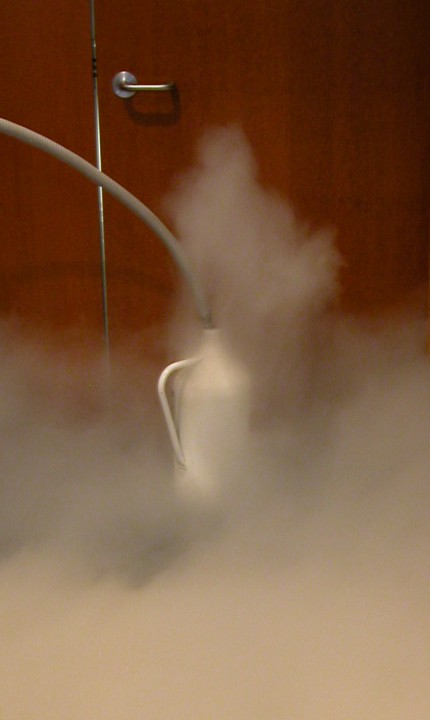Friday, July 20, 2012
Geology Demo - Liquid Nitrogen Base Surge and Downburst
CAUTION: Liquid nitrogen is very cold and presents a serious frostbite
hazard, especially if it gets trapped against your skin (e.g.in your clothing).
Additionally, gaseous nitrogen occupies more volume than the same quantity of
liquid nitrogen. Gaseous nitrogen produced quickly enough in sufficient
quantities can displace oxygen from the air. Containers filled with liquid
nitrogen could fail without warning due to thermal shock or gas pressure.
Protect yourself accordingly.
Base surges and downbursts occur when dense gases sink rapidly down through
less dense gases and spread outward upon impacting the ground. Base surges are
clouds of gas and dust that move along the ground away from a volcanic eruption
or a nuclear explosion. It is often produced when a column of these clouds
collapses to the ground. Downbursts, and smaller microbursts, occur when cold
air sinks to the ground from a thunderstorm. A similar phenomenon seems to occur
during the filling of a typical 4 liter Dewar flask with a relatively narrow
neck from a liquid nitrogen supply line. As the liquid nitrogen (boiling at 77
K) first passes through the supply line and into the flask at room temperature
(about 298 K), the liquid nitrogen flashes into pressurized vapor. The vapor
rushes out of the Dewar flask, creating a column of cool nitrogen vapor and
condensed water droplets. As the supply line cools, liquid nitrogen actually
makes it into the Dewar flask. The liquid nitrogen boils away less rapidly and
the pressure forcing the nitrogen vapor up from the Dewar flask decreases. The
cold dense vapor column then collapses down and spreads across the ground,
resembling a base surge or a downburst.
References:
Clark Johnson. Base Surge.
http://www.geology.wisc.edu/~g111/Terms/base_surge/base_surge.htm (accessed
June, 2006).
Denton County, Texas. Downbursts.
http://www.co.denton.tx.us/dept/main.asp?Parent=82&Link=84#Mistaken
(accessed June, 2006).
BELOW: A liquid nitrogen base surge: (FIRST) Formation of the column of cool
nitrogen vapor and condensed water and (MIDDLE) collapse of the column. (LAST) Surge of air moving out from a thunderstorm rain column near Carlsbad, NM, in June, 2012.
Subscribe to:
Post Comments (Atom)



Excellent post thanks for sharing.
ReplyDeleteMetal Fusion Spraying
Cryogenic liquid containers are generally designed to operate with little or no internal pressure. Inadequate venting can result in excessive gas pressure which could damage or burst the container. Check the unit periodically to be sure that venting is not restricted by accumulated ice or frost.
ReplyDeletethanks a lot for sharing
http://www.inoxindia.com/inoxindia/cryogenic-liquid-nitrogen-container.php